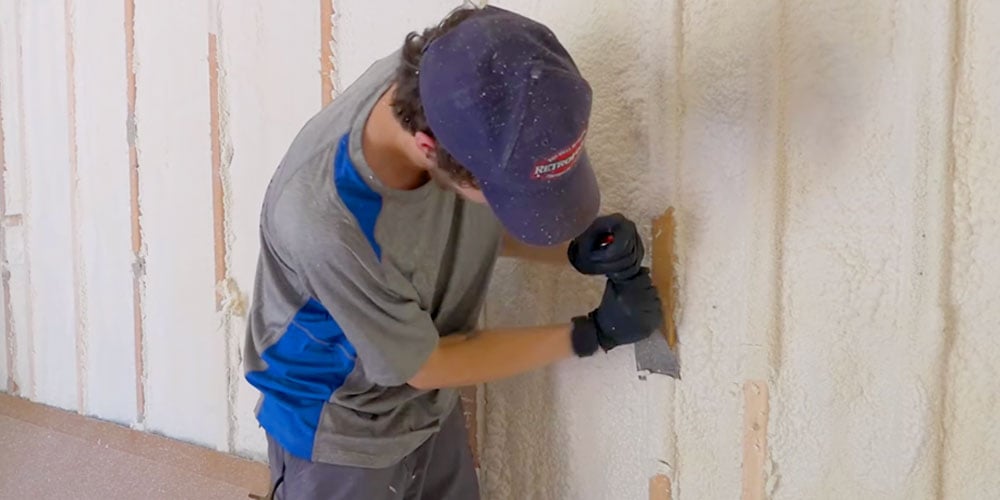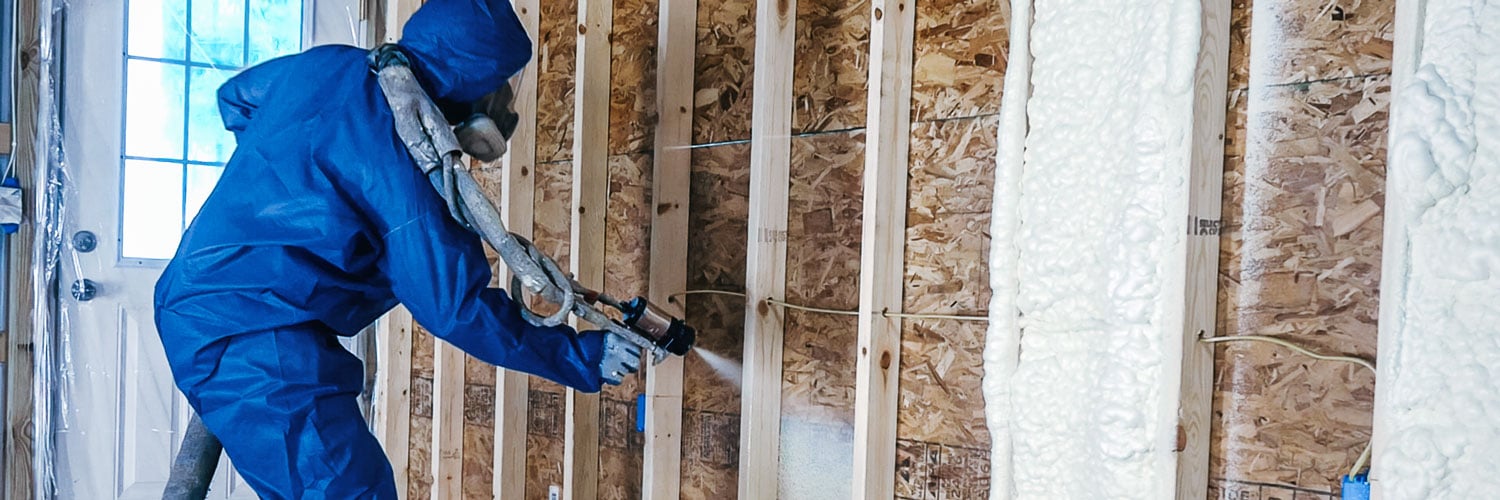The Environmental Impact of Spray Foam: Sustainability Considerations
The Environmental Impact of Spray Foam: Sustainability Considerations
Blog Article
Spray Foam: The Ultimate Service for Air Sealing and Insulation
Spray foam insulation has actually arised as a leading solution for reliable air sealing and thermal insulation, offering a special combination of buildings that set it apart from typical techniques. Understanding the full range of its benefits, installment processes, and contrasts with other insulation types is critical for making educated decisions.
What Is Spray Foam?
Spray foam is a flexible insulation product that integrates the principles of air sealing and thermal resistance to improve power efficiency in structures. Made up primarily of polyurethane or other comparable substances, spray foam is used as a fluid that broadens upon contact with surface areas, producing a strong, continual layer of insulation. This distinct residential or commercial property allows it to fill up gaps, fractures, and spaces that conventional insulation materials might forget, offering a superior air seal.
There are two major kinds of spray foam: open-cell and closed-cell. Open-cell spray foam is lighter and a lot more adaptable, using superb audio absorption and a reduced R-value per inch - Spray Foam. On the other hand, closed-cell spray foam is denser, providing a higher R-value, dampness resistance, and included architectural integrity to constructing parts
The application process generally includes specialized tools, making sure a smooth application that abides by various substratums, including concrete, wood, and steel. This flexibility makes spray foam appropriate for both new constructions and retrofitting existing structures. Its ability to produce an airtight obstacle significantly adds to decreasing energy consumption and enhancing indoor air quality, therefore making it a favored option among home owners and builders alike.
Benefits of Spray Foam Insulation
Among the most considerable benefits of spray foam insulation is its remarkable capacity to produce a continuous air obstacle, which efficiently reduces power loss. Unlike conventional insulation materials, spray foam broadens to fill up cracks and spaces, ensuring that air leak is significantly reduced. This characteristic not only boosts energy efficiency yet likewise causes lower utility costs with time.
Additionally, spray foam insulation offers superior thermal resistance, adding to an extra secure interior setting. Its high R-value per inch enables reliable insulation in constrained areas, making it perfect for attic rooms, wall surfaces, and crawl rooms. The moisture-resistant residential properties of spray foam aid protect against mold and mildew and mildew development, advertising healthier living conditions.
One more crucial advantage of spray foam insulation is its sound-dampening top qualities (Spray Foam). It properly lowers noise transmission between rooms, developing a quieter and extra comfy home atmosphere. The longevity of spray foam additionally stands out, as it does not sag or work out in time, preserving its efficiency throughout its lifespan
Just How Spray Foam Works
Recognizing just how spray foam insulation functions is necessary for appreciating its performance in air sealing and thermal resistance. Spray foam insulation is composed of two key parts: isocyanate and polyol material. When these components are blended, they undergo a chain reaction that causes the material to increase quickly, developing a thick foam that loads tooth cavities, spaces, and splits.
As the foam expands, it follows surfaces, forming a closed seal that considerably decreases air seepage. This characteristic makes spray foam insulation very efficient at avoiding drafts and moisture infiltration, which can result in energy loss and damages in time. Furthermore, the closed-cell version of spray foam offers remarkable thermal resistance because of straight from the source its stiff framework, effectively lessening heat transfer.
The unique properties of spray foam allow it to adapt to uneven surfaces, making sure comprehensive insurance coverage and a seamless obstacle. Because of this, spray foam insulation not just enhances energy performance however additionally adds to enhanced indoor air quality by lowering the build-up of allergens and toxins. Ultimately, comprehending the technicians behind spray foam highlights its duty as a superior option for insulation and air securing in both business and household applications.
Installment Process Review

Before installation, the space has to be effectively cleaned up and prepped, guaranteeing that surface areas are totally free from particles, dirt, and wetness. This step is important because pollutants can compromise attachment and total efficiency. As soon as the location is prepared, the application involves mixing the two parts of the spray foam, which increases upon get in touch with and fills up spaces efficiently.
Trained experts ought to perform the installation, utilizing specialized equipment to make sure consistent coverage and ideal density. Safety and security safety measures, including putting on safety equipment and making sure correct air flow, are essential throughout this process. After application, the foam generally treatments promptly, creating a solid barrier that boosts energy efficiency.
Contrasting Spray Foam to Typical Insulation
When assessing insulation choices, spray foam insulation stands out in comparison to standard materials such as fiberglass and cellulose. Unlike fiberglass and cellulose, which can allow air seepage, spray foam expands article upon application, filling gaps and gaps to create a closed seal.
In addition, spray foam supplies a higher R-value per inch than typical insulation types, offering more reliable thermal resistance in a thinner profile. This particular is specifically useful in areas with minimal cavity depth. Spray foam is resistant to moisture and mold and mildew growth, which can be a substantial concern with cellulose and fiberglass, particularly in damp settings.
Nevertheless, spray foam insulation typically brings a greater upfront price than its traditional counterparts. Property owners need to consider this preliminary investment against lasting power cost savings and efficiency benefits. Inevitably, while both insulation types serve their purpose, spray foam arises as an advanced option for contemporary insulation needs, particularly in regards to air securing and thermal efficiency.

Final Thought
In recap, spray foam insulation stands for an extremely reliable solution for achieving optimal air securing and thermal resistance. Its special residential or commercial properties, including dampness resistance and sound dampening, make it suitable for various applications in both new building and constructions and retrofitting jobs (Spray Foam). Although the initial expenses might be higher contrasted to traditional insulation products, the long-term advantages, such as significant energy savings and boosted interior air quality, justify the financial investment and emphasize its value in contemporary building practices.
Spray foam insulation has actually arised as a leading solution for effective air sealing and thermal insulation, supplying a special mix of buildings that establish it apart from standard approaches.Spray foam is a flexible insulation product that incorporates the concepts of air securing and thermal resistance to enhance energy performance in structures.When reviewing insulation choices, spray foam insulation stands out in comparison look at these guys to conventional products such as fiberglass and cellulose. Inevitably, while both insulation kinds serve their objective, spray foam arises as a much more innovative service for modern insulation requirements, specifically in terms of air securing and thermal effectiveness.
In summary, spray foam insulation stands for an extremely effective service for achieving ideal air securing and thermal resistance.
Report this page